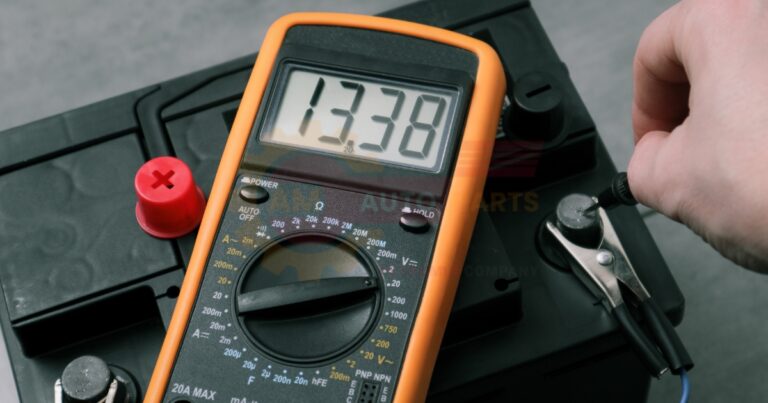How to Read Car Battery Gauge
Understanding how to read a car battery and its gauge is crucial for maintaining your vehicle’s health. A car battery is the heart of your vehicle’s electrical system, and knowing how to interpret its readings can save you from unexpected breakdowns. This guide will walk you through the essentials of reading car battery gauges, understanding normal readings, and troubleshooting potential issues.
Car battery gauges and voltmeters are essential tools for monitoring the health of your vehicle’s battery. They provide real-time data on the battery’s voltage, helping you assess its condition.
Types of Battery Gauges in Vehicles
There are several types of battery gauges found in vehicles, each serving a unique purpose. The most common types include analog voltmeters, digital voltmeters, and battery indicator lights. Analog voltmeters use a needle to display voltage levels, while digital voltmeters provide a numerical readout. Battery indicator lights, often found on the dashboard, alert drivers to potential issues with the battery.
- Analog Voltmeters : Use a needle to show voltage levels.
- Digital Voltmeters : Provide a numerical voltage readout.
- Battery Indicator Lights : Alert drivers to battery issues.
Importance of Monitoring Battery Health
Monitoring your car battery’s health is vital for ensuring your vehicle runs smoothly. A healthy battery ensures reliable starts and efficient operation of electrical components. Regularly checking the battery gauge can help you identify issues early, preventing costly repairs and inconvenient breakdowns.
- Reliable Starts : A healthy battery ensures your car starts reliably.
- Efficient Operation : Electrical components function optimally with a good battery.
- Early Issue Detection : Regular checks help catch problems before they escalate.
Interpreting Battery Gauge Readings
Understanding how to interpret battery gauge readings is key to maintaining your vehicle’s performance. Knowing what constitutes a normal reading and recognizing signs of a weak battery can help you take timely action.
Normal Voltage Range for Car Batteries
A typical car battery should read between 12.4 and 12.7 volts when the engine is off. When the engine is running, the voltage should be between 13.7 and 14.7 volts. These readings indicate that the battery is charging properly and is in good condition.
- Engine Off : 12.4 to 12.7 volts
- Engine Running : 13.7 to 14.7 volts
Signs of a Weak or Failing Battery
A weak or failing battery often shows signs such as dim headlights, slow engine crank, and frequent need for jump-starts. If your battery gauge consistently reads below 12.4 volts, it may be time to consider a replacement.
- Dim Headlights : Indicate insufficient power.
- Slow Engine Crank : Suggests a weak battery.
- Frequent Jump-Starts : A sign of a failing battery.
Troubleshooting High Battery Gauge Readings
High battery gauge readings can indicate potential issues with your vehicle’s charging system. Understanding the causes and implications of these readings is essential for maintaining battery health.
Causes of Abnormally High Voltmeter Readings
Abnormally high voltmeter readings, typically above 14.7 volts, can be caused by a faulty voltage regulator or alternator. These components are responsible for controlling the amount of voltage sent to the battery, and any malfunction can lead to overcharging.
- Faulty Voltage Regulator : Can cause overcharging.
- Malfunctioning Alternator : May send excessive voltage to the battery.
Potential Issues with Charging System Components
Issues with charging system components can lead to battery damage and reduced lifespan. Overcharging can cause the battery to overheat, leading to electrolyte loss and potential failure.
- Battery Damage : Overcharging can damage the battery.
- Reduced Lifespan : Excessive voltage shortens battery life.
- Overheating : Can lead to electrolyte loss and failure.
Low Battery Gauge Readings and Their Implications
Low battery gauge readings can have significant implications for your vehicle’s performance. Understanding the common causes and effects of low voltage readings is crucial for maintaining your car’s reliability.
Common Reasons for Low Voltage Readings
Low voltage readings, typically below 12.4 volts, can be caused by a variety of factors, including a weak battery, poor connections, or a failing alternator. Identifying the root cause is essential for addressing the issue effectively.
- Weak Battery : May not hold a charge.
- Poor Connections : Can lead to voltage drops.
- Failing Alternator : May not charge the battery properly.
Impact on Vehicle Performance and Starting
Low battery voltage can lead to poor vehicle performance and starting issues. A battery that cannot hold a charge may result in dim lights, slow cranking, and even a no-start condition. Battery drain radio uses more power from your phone than other apps This can make your battery run out faster when listening to Automotive power failure happens when a car’s electrical system stops working properly This can cause problems like the engine not starting or lights not turning on
Car voltage levels Most cars use a 12-volt electrical system to power lights and other components while some hybrid and electric vehicles have higher voltage systems for their motors Jumpstart dead battery is a quick way to get your car running again when the battery is out of power You can use special cables to connect your car’s dead battery to another working car’s battery to give it a boost
Electrical system weakens when power lines get old or damaged This can cause lights to flicker and appliances to work poorly Battery selection guide Choose the right battery for your device by looking at size voltage and how long it lasts
Electric vehicle safety is about making sure electric cars are safe to drive and use These cars have special features to protect people from electrical problems and accidents
- Dim Lights : Indicate insufficient power.
- Slow Cranking : Suggests a weak battery.
- No-Start Condition : A sign of a failing battery.
Maintaining Optimal Battery Health
Maintaining optimal battery health is essential for ensuring your vehicle’s reliability. Regular checks and proper care can extend the life of your battery and prevent unexpected issues.
Regular Battery Checks and Maintenance Tips
Regular battery checks and maintenance can help you catch potential issues early. Inspecting the battery terminals for corrosion, ensuring tight connections, and testing the battery’s voltage are essential steps in maintaining battery health.
- Inspect Terminals : Check for corrosion.
- Ensure Tight Connections : Prevent voltage drops.
- Test Voltage : Regularly check battery voltage.
Extending Battery Life Through Proper Care
Proper care can significantly extend your battery’s life. Avoiding short trips, keeping the battery clean, and ensuring the charging system is functioning correctly are key practices for prolonging battery life.
- Avoid Short Trips : Allow the battery to charge fully.
- Keep Battery Clean : Prevent corrosion buildup.
- Check Charging System : Ensure it’s working properly.
FAQ’s
What is the Normal Reading for a Car Battery Gauge?
The normal reading for a car battery gauge varies depending on whether the engine is running or off. When the engine is off, a healthy battery should read between 12.4 and 12.7 volts. With the engine running, the reading should be between 13.7 and 14.7 volts. These readings indicate that the battery is in good condition and charging properly.
How Do I Know if My Car Battery is Fully Charged?
A fully charged car battery typically reads around 12.6 volts when the engine is off. If your voltmeter shows this reading, your battery is likely fully charged. It’s important to regularly check the battery’s voltage to ensure it maintains a full charge, especially if the vehicle is not used frequently.
Can a Bad Alternator Cause High Battery Gauge Readings?
Yes, a bad alternator can cause high battery gauge readings. The alternator is responsible for charging the battery and supplying power to the vehicle’s electrical systems. If it malfunctions, it can send excessive voltage to the battery, leading to overcharging and potentially damaging the battery.
What Should I Do if My Battery Gauge is Reading Low?
If your battery gauge is reading low, it’s important to address the issue promptly. Start by checking the battery connections for corrosion or looseness. If the connections are fine, test the battery’s voltage and consider having the alternator checked. A persistently low reading may indicate a failing battery or charging system issue.
How Often Should I Check My Car’s Battery Gauge?
It’s recommended to check your car’s battery gauge at least once a month. Regular checks can help you catch potential issues early and ensure your battery remains in good condition. Additionally, checking the battery gauge before long trips or during extreme weather conditions can prevent unexpected breakdowns.






